Bangladesh in Color: The Most Influential Painters
- 1. Zainul Abedin (1914-1976)
- 2. Quamrul Hassan (1921-1988)
- 3. Safiuddin Ahmed (1922-2012)
- 4. Hashem Khan (1941)
- 5. S.M. Sultan (1923-1994)
- 6. Murtaja Baseer (1932-2020)
- 7. Qayyum Chowdhury (1932-2014)
- 8. Rafiqun Nabi (1943)
- 9. Shahabuddin Ahmed (1950)
- 10. Kanak Chanpa Chakma (1963)
- 11. Tayeba Begum Lipi (1969)
- 12. Monirul Islam (1943)
- 13. Aminul Islam (1931-2011)
Have you ever been to Bangladesh? This South Asian country, nestled between India and the Bay of Bengal, is a land of remarkable contrasts and vibrant traditions. Beyond its scenic landscapes and rich cultural heritage, Bangladesh holds a special place in the world of art!
Bangladeshi art is deeply rooted in the country's history, with influences ranging from ancient Buddhist and Hindu traditions to the rich Islamic heritage introduced during the medieval period. This fusion has given birth to a diverse artistic landscape, characterized by intricate terracotta plaques, pottery, sculpture, and elaborate manuscript illustrations. In modern times, the art scene in Bangladesh has been marked by the Bengal School of Art movement, which sought to revive and redefine Indian art traditions under British colonial rule, laying the groundwork for modern artistic expressions in Bangladesh.
The 20th century saw the emergence of distinctive features in Bangladeshi art, with artists exploring themes of national identity, social injustice, and human resilience. The Liberation War of 1971, a pivotal moment in the country's history, inspired a generation of artists to depict the struggles and aspirations of the Bangladeshi people, making political and social commentary a significant theme in their work. Special groups of artists, such as the Charukala group and the Dhaka Art Summit, have played crucial roles in promoting contemporary art and fostering dialogue among artists both locally and internationally. These collectives and events have helped to spotlight Bangladesh on the global art stage, showcasing the country's dynamic blend of tradition and innovation.
Whether through the evocative paintings of the Bengal School, the poignant works born from the Liberation War, or the cutting-edge contemporary pieces that challenge and redefine boundaries, Bangladeshi art continues to captivate and inspire audiences around the world. Today, we will look at the top 13 notable Bangladeshi artists, who were changing the art world of South Asia!
1. Zainul Abedin (1914-1976)
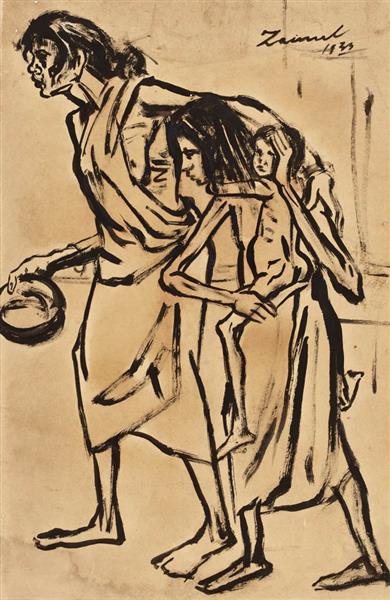
Zainul Abedin "Famine Sketches" 1943
Zainul Abedin, revered as the founding father of Bangladeshi art, was an iconic figure whose works transcended mere aesthetic appeal to capture the essence of his country's spirit and struggles. Representing the Bengal School of Art movement, his art was a harmonious blend of traditional and modernist techniques, deeply rooted in the socio-political context of his time. Abedin's style was distinctive for its profound empathy and realism, characterized by flowing lines and a masterful use of ink and wash technique. Among his most famous works, the "Famine Sketches" series stands out, created during the devastating Bengal Famine of 1943. These sketches are a poignant testament to Abedin's deep compassion for the rural poor, capturing their dignity amidst dire adversity. Another notable piece, "Struggle," embodies the spirit of the Bangladeshi Liberation War, showcasing Abedin's commitment to depicting the realities of conflict and hope for freedom. Undoubtedly, Abedin's art is unique not only for its aesthetic characteristics, but also for its historical relevance and long-lasting impact on Bangladesh's cultural identity.
2. Quamrul Hassan (1921-1988)

Quamrul Hassan - "Peacock And Parrot" 1976
Quamrul Hassan, often referred to as the "Rebel Artist", was a key figure in the country's art scene, known for his profound influence on the development of modern art in Bangladesh. His work spanned several decades, marked by a fierce individualism and a commitment to social and political themes. Hassan was a versatile artist, dabbling in a variety of mediums including painting, drawing, printmaking, and sculpture, but it was his bold and satirical approach to art that set him apart. A significant aspect of Hassan's work was his representation of the common people and their struggles, reflecting his deep connection to the socio-political realities of Bangladesh. His art also often contained sharp critiques of social injustice and political corruption, rendered with a sense of humor and irony that made his messages both accessible and impactful. "Bir Bangali" (The Brave Bengali), which he created during Bangladesh's Liberation War in 1971, is one of his most well-known pieces. This powerful piece served as a symbol of resistance and patriotism, showcasing Hassan's ability to capture the spirit of a nation fighting for its independence. Another notable work, "The Famine Series," highlights the artist's sensitivity to human suffering, depicting the harsh realities of famine in Bengal. Quamrul Hassan's style was characterized by its expressive lines, vibrant colors, and the integration of folk elements, which added a distinct Bangladeshi character to his work. He was not only a prominent artist but also an influential teacher and mentor to many young artists, playing a crucial role in shaping the art education system in Bangladesh.
3. Safiuddin Ahmed (1922-2012)
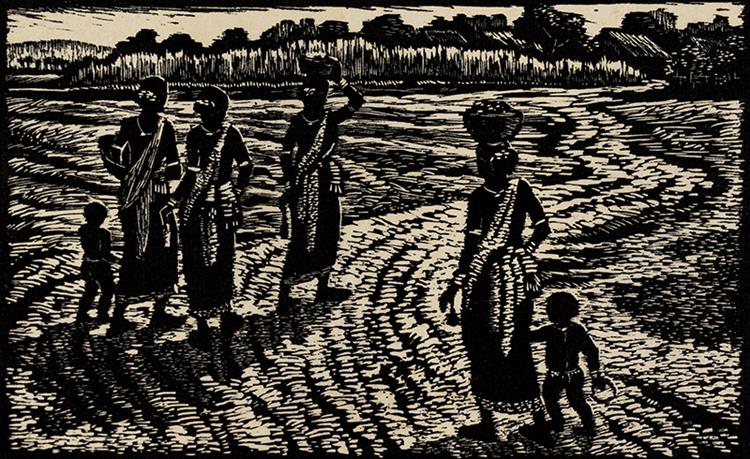
Safiuddin Ahmed - Santal Woman & Child, 1942
Safiuddin Ahmed stands as a luminary in the art world of Bangladesh, acclaimed for his pioneering role in introducing and mastering printmaking and etching techniques within the region. Safiuddin's oeuvre is a rich tapestry of landscapes, rural scenes, and historical narratives, captured with an intricate precision and depth that printmaking allows. His commitment to the craft brought a new dimension to Bangladeshi art, emphasizing the power of line, texture, and shadow. Among his celebrated works, "The Rickshaw Puller" and "Rural Bangladesh" stand out, showcasing his exceptional ability to convey both the resilience and the vulnerabilities of the common people against the backdrop of their everyday lives. Ahmed's style is marked by a meticulous attention to detail and a profound understanding of the dynamics of light and shadow, making his prints not just visually compelling but emotionally resonant as well. Safiuddin Ahmed's legacy is engraved not just on plates and prints but in the hearts of those who see the world through his eyes — a world where art is an unyielding echo of humanity.
4. Hashem Khan (1941)
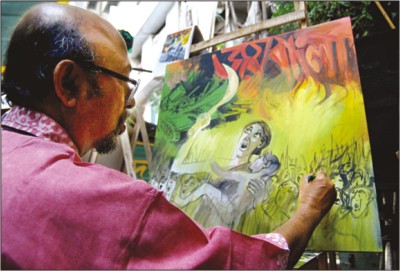
Hashem Khan
Hashem Khan, a stalwart of Bangladeshi art, is celebrated for his vibrant depictions of the country's rural life, folklore, and cultural heritage. His work is characterized by a rich palette, dynamic compositions, and a profound sense of empathy towards his subjects. Through his paintings, Khan invites viewers to experience the essence of Bangladeshi life, its people, and their stories... One of his notable series, "The Liberation War," captures the tumultuous period of Bangladesh's struggle for independence in 1971. These paintings are not just visual records but emotional narratives that convey the resilience and courage of the Bangladeshi people, a theme that resonated deeply with many artists of that time. Another significant work, "Folk Festivities," celebrates the vibrant festivals and traditions that are integral to Bangladeshi culture, showcasing Khan's ability to capture the joy and communal spirit of these occasions. Hashem Khan's style is distinctive for its fusion of realism with elements of abstraction, where the literal and the metaphorical coalesce to create a unique visual language.
5. S.M. Sultan (1923-1994)
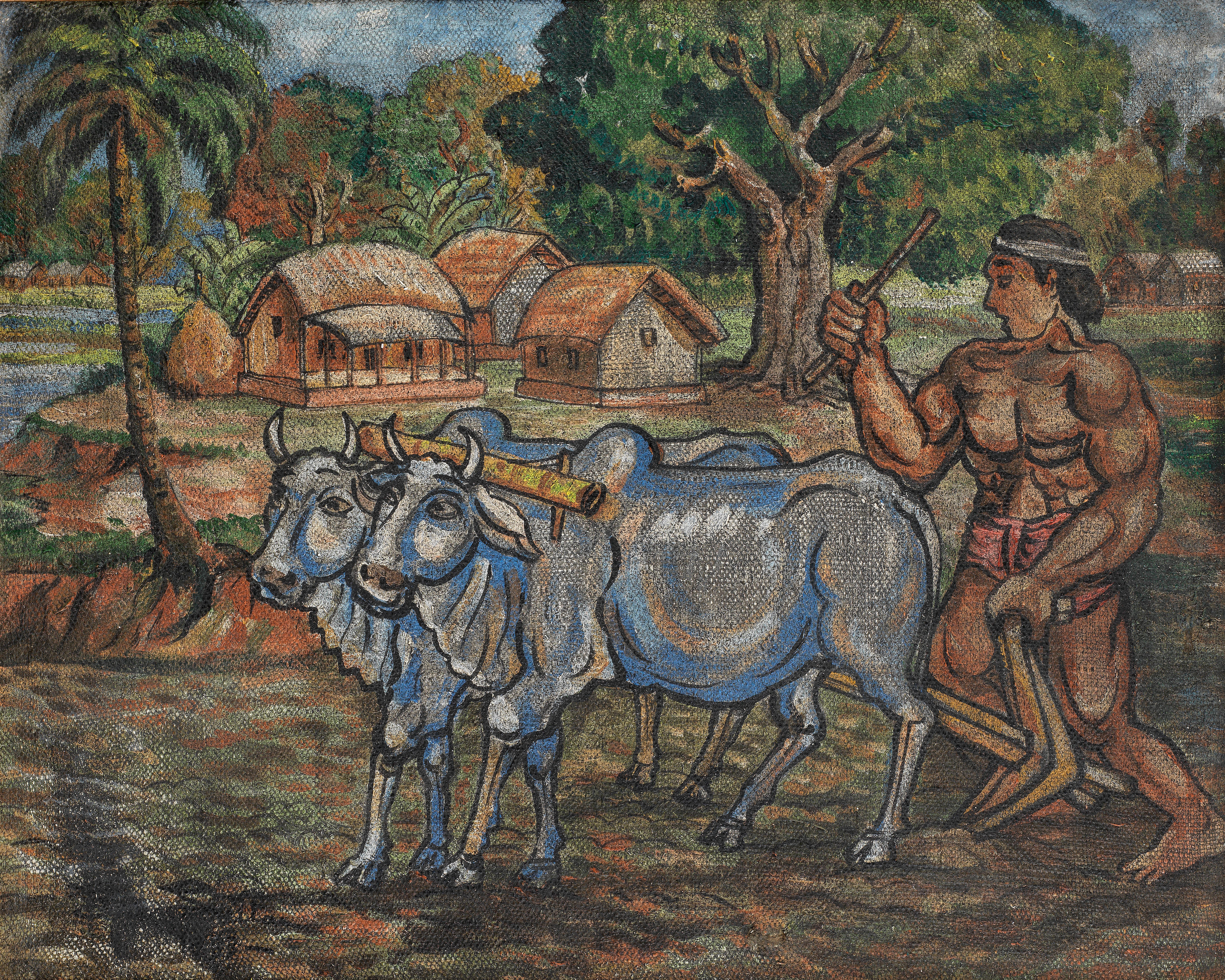
Sheikh Mohammed Sultan
Sheikh Mohammed Sultan (known as S.M. Sultan) is celebrated for his profound and idyllic representations of rural Bangladesh. His paintings are characterized by their portrayal of muscular, larger-than-life peasants engaged in daily agricultural activities, symbolizing the strength, dignity, and indomitable spirit of the common man. Sultan's artistic vision was deeply influenced by his empathetic connection with the rural populace, whose lives and labors he elevated to heroic proportions. His signature style combines realism with a sense of idealism, where the lush landscapes of Bangladesh serve as a backdrop for the human figures that dominate his canvases. "Life of a Farmer" and "Nabanna" (The Festival of New Harvest) are two of his most well-known works. These paintings not only showcase Sultan's mastery over form and composition but also encapsulate his philosophical reflections on life, labor, and the innate connection between human beings and the earth. What's more, he was a visionary who valued the peasant class in society and promoted the dignity of work via art as a tool for social transformation. His work has inspired generations of artists and continues to resonate with audiences, serving as a testament to the enduring beauty and resilience of rural Bangladesh!
6. Murtaja Baseer (1932-2020)

Murtaja Baseer, a multifaceted talent in the panorama of Bangladeshi art, was an artist whose works span a wide spectrum of styles and themes, reflecting a deep engagement with the cultural, social, and existential dimensions of human life. Baseer's artistic journey was marked by a relentless quest for new modes of expression, blending elements of realism, surrealism, and abstract art to explore the complexities of human existence. He was adept at using a variety of mediums, from oil and acrylic to mixed media, to convey his nuanced understanding of reality and imagination. Among his significant works, "Metamorphosis" is a prime illustration of his ability in depicting transforming human experiences, while "Eternal Quest" represents his contemplation on the never-ending human search for meaning and truth. Baseer was also known for his contributions to the development of art education in Bangladesh, influencing generations of artists as a revered teacher and mentor. His art remains a vibrant testament to the power of creativity in capturing the essence of human experience.
7. Qayyum Chowdhury (1932-2014)

Qayyum Chowdhury
Qayyum Chowdhury, known for his contributions that spanned over several decades, beginning in the early years of the country's fight for independence. Chowdhury's art is celebrated for its deep connection to the cultural and social fabric of Bangladesh, reflecting the essence of its landscapes, people, and heritage. He had a unique ability to capture the spirit of Bangladeshi life, from the bustling markets and serene rural landscapes to the vibrant cultural festivals that define the nation's identity. Thus, his work "The Fisherman," exemplifies Chowdhury's skill in depicting the life of rural Bangladesh, showcasing not only the physical labor of the fishermen but also their symbiotic relationship with nature. Another significant piece, "Harvest," celebrates the agricultural life that is the backbone of the country, portraying the harvest season with a palette that bursts with the colors of prosperity and fertility. Throughout his career, Qayyum Chowdhury remained committed to exploring themes of social realism, often using his art as a medium to comment on social inequalities and to advocate for the dignity of the working class. His style, while rooted in realism, also incorporated elements of abstraction and expressionism, allowing him to convey complex emotional and social narratives through his paintings...
8. Rafiqun Nabi (1943)
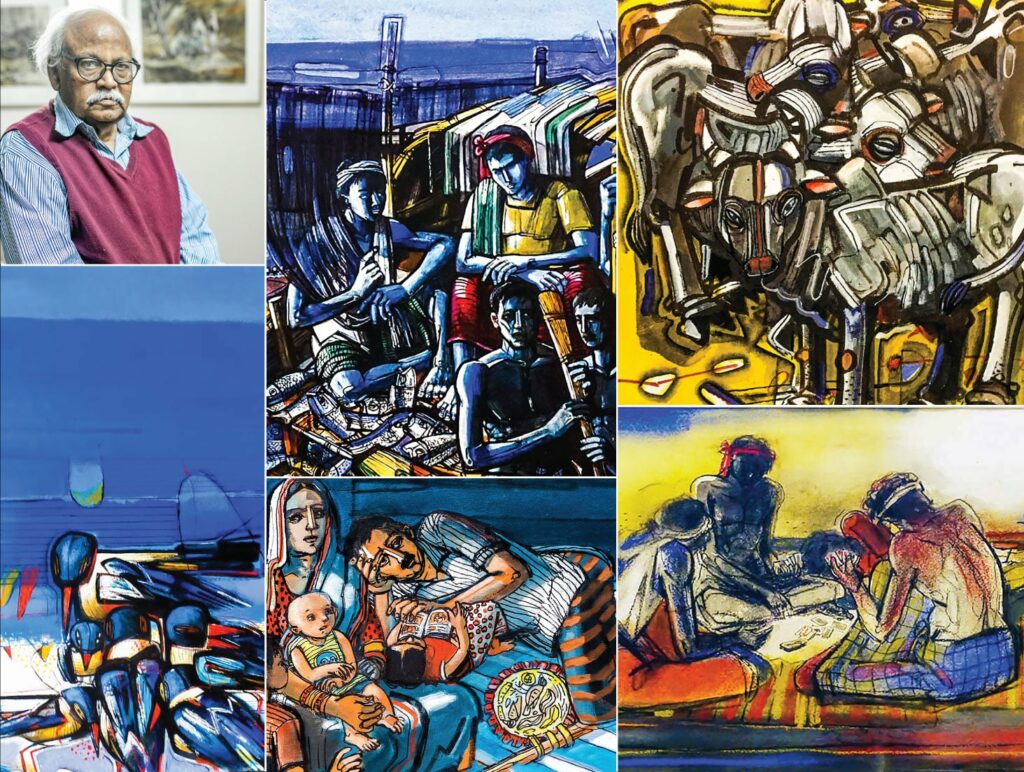
Rafiqun Nabi
Rafiqun Nabi, affectionately known as Ranabi, is celebrated for his versatility as an artist, cartoonist, and illustrator. Born in 1943, Nabi's work spans several decades and is characterized by a unique blend of humor, satire, and poignant social commentary, making him a beloved and influential figure in Bangladesh. Perhaps best known for creating the iconic character "Tokai" in the 1970s, a street-smart, homeless boy whose adventures and insights offer a critique of societal inequalities and political corruption. Tokai became not just a character but a symbol of the resilience and wit of the underprivileged in Bangladeshi society. Through Tokai, Nabi has been able to address complex social issues with simplicity and humor, making his work accessible and relatable to a broad audience. Nabi's artistic style is marked by its expressive line work and vibrant use of color. Beyond his caricatures and cartoons, Nabi's fine art is equally compelling, showcasing his deep understanding of human nature and his keen observation of the world around him. His ability to weave together humor, critique, and beauty has endeared him to generations of Bangladeshis, making him a cherished national treasure…
9. Shahabuddin Ahmed (1950)

Shahabuddin Ahmed "Shanti" (Peace)
Shahabuddin Ahmed is a distinguished Bangladeshi painter, celebrated for his dynamic and powerful depictions of the human spirit and freedom. Ahmed's style is characterized by its vigorous brushstrokes and bold use of color, creating compositions that are both visually striking and emotionally charged. His subjects, often depicted in heroic poses, seem to be in a state of movement, symbolizing the struggle and triumph of the human will. This unique approach has placed him among the most prominent contemporary artists in Bangladesh! "Shanti" (Peace) and "Durbar" (Unstoppable) are paintings that capture the essence of emancipation and the fight for justice, combining themes from Shahabuddin Ahmed's career in a unified, engaging narrative. His ability to convey intensity and emotion through his art has made these works resonate with a wide audience, both domestically and internationally. His contributions to the art world have been even acknowledged with numerous awards, including the prestigious Ekushey Padak, one of Bangladesh's highest civilian honors.
10. Kanak Chanpa Chakma (1963)
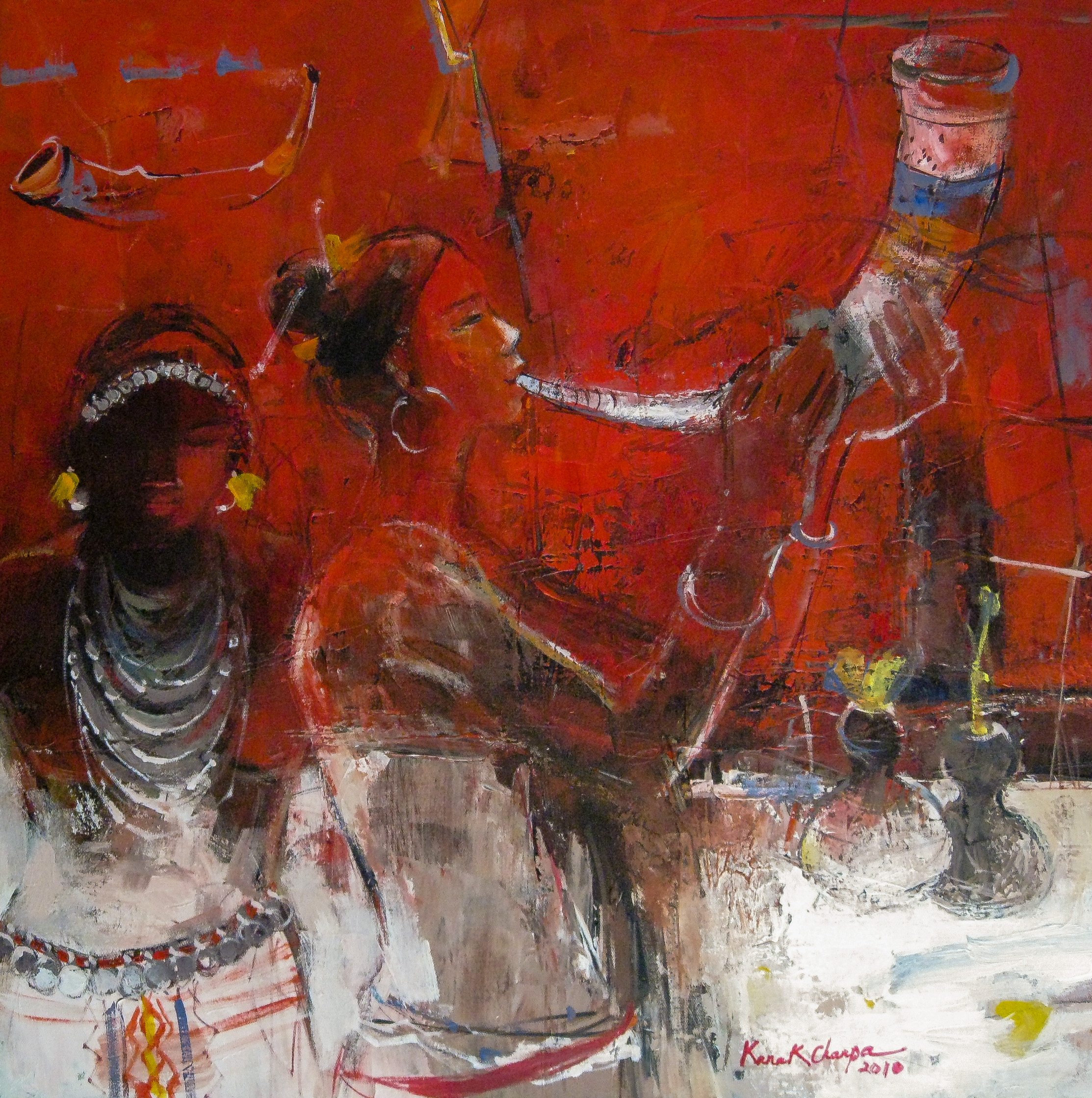
Kanak Chanpa Chakma "Monsoon Rhythms"
Kanak Chanpa Chakma is a distinguished Bangladeshi artist known for her vivid portrayal of the life, culture, and struggles of the indigenous people of the Chittagong Hill Tracts. Her art often features traditional motifs, landscapes, and scenes from everyday life, rendered with a sensitivity and authenticity that comes from her own experiences and connections to the Chittagong Hill Tracts.Two of her notable works, "The Hills in Bloom" and "Monsoon Rhythms," exemplify her ability to blend traditional themes with contemporary artistic expressions. These pieces not only showcase the beauty and vibrancy of indigenous cultures but also highlight the environmental and socio-political challenges they face. Chakma's style, characterized by its dynamic use of color and expressive forms. What is more, Chakma's work serves as a bridge between the indigenous communities of Bangladesh and the wider world, showcasing the rich traditions and stories of her people.
11. Tayeba Begum Lipi (1969)

Tayeba Begum Lipi Work "Love Bed"
Tayeba Begum Lipi is a contemporary Bangladeshi artist known for her innovative and provocative works that explore themes of femininity, gender, and identity through a variety of mediums including sculpture, video, and installation art. Lipi co-founded the Britto Arts Trust, Bangladesh's first artist-led collective and alternative arts platform, which plays a crucial role in promoting contemporary art practices in the region. Lipi's art often incorporates everyday objects and materials in unexpected ways to challenge and deconstruct societal norms and expectations surrounding women's roles and bodies. One of her most notable series involves the use of stainless steel razor blades to create objects associated with women, such as lingerie and baby strollers. This choice of material serves as a powerful metaphor for the beauty and danger inherent in female societal roles, reflecting the sharp contrasts between public perceptions and private realities. Her work "Love Bed," an installation piece made from stainless steel razor blades, is a striking example of her ability to blend beauty with a sense of discomfort, inviting viewers to reconsider their notions of comfort, intimacy, and vulnerability. Similarly, her series of sculptural works featuring traditional Bengali bridal attire, rendered in metal, interrogates the complexities of marriage and the expectations placed on women. Tayeba Begum Lipi's art continues to inspire and provoke, challenging audiences to rethink the intersections of culture, gender, and identity.
12. Monirul Islam (1943)
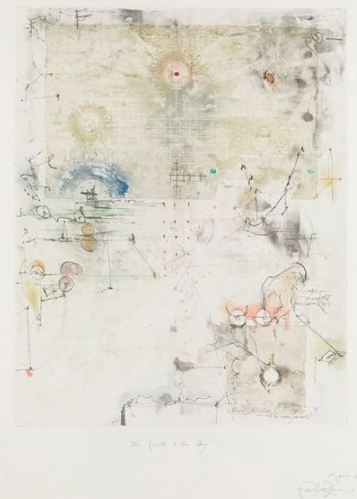
Monirul Islam "The Earth And The Sky"
Monirul Islam is a celebrated Bangladeshi-Spanish artist, known for his pioneering contributions to the world of contemporary art. He was blending elements from his Bangladeshi heritage with influences from his life in Spain, where he has resided since the 1960s. His paintings often feature a rich tapestry of symbols and motifs that draw from both his cultures, creating a dialogue between the Eastern and Western artistic traditions. This fusion is evident in his innovative use of materials and techniques, incorporating etching, aquatint, and mixed media to explore themes of human emotion, nature, and existentialism. Among his renowned works, "Mystic Calligraphy" and "The Earth and the Sky" stand out for their detailed detail and profound depth, demonstrating Islam's ability to convey complex ideas through abstract forms. Islam's contributions to art have been recognized with numerous awards and honors, including the prestigious National Art Award (Ekushey Padak) in Bangladesh and the Order of Isabella the Catholic in Spain, highlighting his role as a cultural ambassador between his homeland and his adopted country. Monirul Islam's legacy is one of innovation, bridging diverse artistic landscapes and fostering a unique cross-cultural dialogue through his creations.
13. Aminul Islam (1931-2011)

Aminul Islam
Despite sharing the same surname, which is common in Bangladesh and Muslim communities worldwide, there is no publicly available information suggesting a familial relationship between Monirul and Aminul Islam. Aminul Islam was a prominent artist, recognized for his significant contributions to the development of modern art in Bangladesh. His body of work is celebrated for its diversity and depth, encompassing a wide range of styles from abstract expressionism to figurative art. Aminul Islam was not only a prolific painter but also an esteemed educator, dedicating much of his life to teaching and mentoring young artists at the Institute of Fine Arts (now the Faculty of Fine Art, University of Dhaka). One of his most prominent pieces, "The Rebel," exemplifies Islam's style, with dynamic compositions and a colorful palette that portray movement and emotional intensity. Islam has received recognition and honors for his work even outside of Bangladesh due to international exhibitions of his artwork.
For those eager to explore further into the realms of artistic brilliance, the TrendGallery website offers a gateway to discovering renowned painters from around the world, enriching your understanding of the vast and varied world of art.
No Comments Yet...